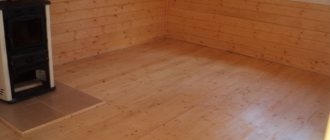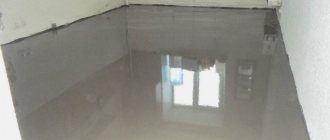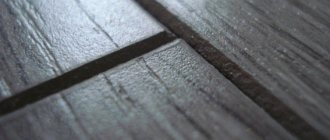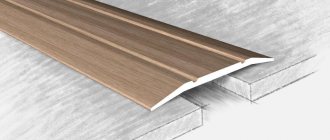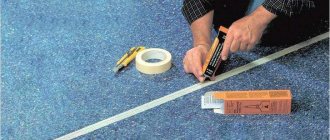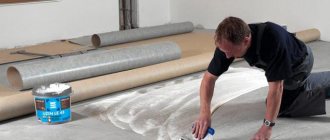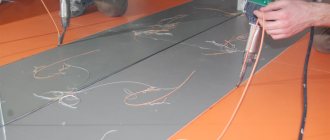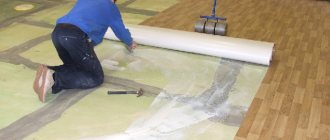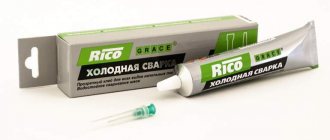According to building codes, any linoleum must be laid using the adhesive method - solid or edge. Depending on the type of coating and thickness, select the appropriate adhesive for linoleum to achieve the desired result. If the glue is chosen correctly, there will be no waves or bubbles, the edges will not beaded (raised), and there will be no traces of feet or furniture.
In order for you to make the right decision, we have prepared a rating of adhesive compositions for linoleum for various purposes. Also in the article you will learn how to glue linoleum to the floor, whether it is necessary to glue it at all and what is the glue consumption per sq.m.
| Category | Name | Price, kg/rub. | brief information |
| The best adhesive for linoleum on concrete floors | Axton | 1,3/193 | Universal. Suitable for linoleum, carpet. Apply to any substrate, including porous ones, with a roller or spatula. Has good frost resistance. Consumption 0.2 kg/m2. |
| TYTAN Professional | 14/2100 | One-component water-dispersion adhesive. Suitable for absorbent building substrates such as concrete, plasterboard and wood. | |
| Homakoll 208 | 14/2730 | Suitable for household and commercial linoleum, carpet, cork, and any other artificial floor coverings for concrete, cement screed, wood, chipboard, fiberboard. Consumption 300-500 g/m2. | |
| The best adhesive for linoleum on wood floors | CS "Optimist" | 18/474 | Ready-made heat-resistant composition based on liquid glass, with the addition of latex and thermoplastic polymers. The structure is viscous, seals cracks and cracks. The coating does not bubble. |
| TEX KS Construction | 18/510 | Universal. Heat resistant – up to 400°C. High adhesion to complex materials - concrete, glass, wood and even tiles. | |
| EXPERT Bustilat | 1,3/104 | For all artificial coverings on concrete, wooden floors, chipboard, OSB. Consumption per meter is 500-600 g with continuous application, dries within 24 hours at a temperature of 20 °C. | |
| The best acrylate adhesive for linoleum and seams | Homakoll 248 | 1/127 | Acrylic resin based mixture. It is characterized by high adhesion and viscosity, which ensures excellent adhesion of the coating to the floor. For semi-commercial PVC covering. Consumption 300 – 500 g/m2. |
| Polynomial 101 | 18/1630 | For all floor coverings on PVC, jute, foam base. Apply to vapor- and water-permeable substrates. Consumption 300-500 g/sq.m. | |
| Krass | 14/1820 | Suitable for household and semi-commercial PVC coverings. Withstands 10 freezing temperatures down to -40°C. Does not shrink, does not deform. | |
| Best Adhesive for Commercial Linoleum | Forbo 522 Eurosafe Star Tack | 13/3100 | High adhesive power, easy to apply, solvent-free. |
| NORME COLOR PROFI | 14/2100 | Provides high shear and peel strength of the adhesive bond. Does not contain volatile solvents. It is not pressed through by heavy objects and under prolonged load. | |
| Thomsit L 240 D/14 | Suitable for linoleum up to 2.5-4 mm thick. Does not shrink. Suitable for heated floors. Withstands point loads (from furniture on casters). Maximum 5 cycles of freezing down to -40°C. | ||
| Adhesive for linoleum cold welding | Werner Müller Tarkett | 0,044/480 | The adhesive composition for welding type “A” linoleum contains a large percentage of solvent. 44 grams is enough for 20 meters of seams, making them monolithic. |
| SINTEX H-44 | 0,1/230 | For cold joining of seams. Forms an invisible film, prevents shrinkage and beading of seams in the joint area. | |
| Economy | 0,05/150 | For butt gluing linoleum. The kit includes a special nozzle that is convenient for applying to the edges. |
Is it necessary to glue linoleum to the floor?
Manufacturers are unanimous on this issue – definitely. Buyers were divided into 3 fronts - some are categorically against, others are in favor of continuous gluing, and others are only in favor of edge gluing. The truth, as usual, is somewhere in the middle.
Depending on the expected load, you need to choose both the method and what kind of glue to glue the linoleum with. If the load is minimal. You can even get by with double-sided tape, and fix the edges end-to-end with cold welding.
If the room is spacious and large, and the covering is laid entirely, you can glue only the edges using cold welding. If several pieces are being rolled out, you need to apply glue in a continuous layer, then there will be no displacement, waves or bubbles. The edges are separately fixed by cold welding.
Even in small rooms, it is advisable to apply a continuous layer of the composition to ensure reliable contact of the canvas with the base, increase its wear resistance and eliminate deformation when moving objects.
Summarize
If you are one of those who prefer this flooring, then this information should be useful to you. Now you know how to glue linoleum together, and this can be done in a variety of ways. Gluing the joints is necessary, because this primarily protects the coating from swelling, and also does not allow debris to accumulate, which is ultimately difficult to get out.
Which method you will use primarily depends on your type of coating. Remember that hot welding cannot be used for thin and not very durable floor coverings, and it is better to use double-sided tape only for temporarily fastening strips.
The best adhesive for linoleum on concrete floors
Since concrete strongly absorbs water, you need to choose an adhesive based on acrylic or polyvinyl acetate. It does not retain water and provides reliable and uniform adhesion of two surfaces. If you choose another type of composition, after a while it will begin to dry out due to lack of moisture.
It is best to purchase linoleum with fabric insulation, alkyd (glypthal) for a concrete floor. If there is no base, fiberboard, chipboard, or OSB slabs are laid on the concrete base.
Axton
The universal composition is intended for laying PVC floors, vinyl, textile and carpet coverings. Designed for high temperatures - up to +65°C, thanks to which it is possible to lay a heated floor on the system. It dries within half an hour - during this time you need to have time to roll out the coating in order to lay it on a damp base. Complete drying within 36 hours. Contains no solvents, so no ventilation is required.
Axton
It can be applied with a roller or a special notched trowel, the main thing is that the layer is uniform. Builders recommend using a roller to prevent paths from forming. After the composition has been distributed on the surface, leave it for 10 minutes, after which the canvas is rolled out.
Pros:
- sets quickly;
- due to the liquid base it is easy and evenly applied.
Minuses:
- after a day it is no longer possible to tear off the coating.
TYTAN Professional
A one-component water-dispersible rubber-based composition, produced in the form of a beige paste, making untreated areas clearly visible. Used for gluing natural and artificial linoleum, fabric and PVC based, carpet. Specially designed for concrete and wooden bases - it has good adhesion, forms an elastic and moisture-resistant base.
TYTAN Professional
Apply with a roller or spatula, dry for 5-10 minutes, after which the roll is rolled out. It dries within 24 hours, during which time you cannot walk on it or place any objects on it to prevent dents from forming.
Homakoll 208
Designed and intended for fixing rolled floor coverings on foam, pile or woven backing to concrete, cement and wood substrates that absorb water. Placed on a wet adhesive layer.
The composition does not contain volatile solvents, does not shrink when dried, has good adhesion, and does not dry out at the edges. Apply with a spatula or roller to a previously prepared floor.
Homakoll 208
Preliminary preparation means cleaning the surface from debris, dust, paint, fats and mastic, drying it to the maximum level. If the base is highly porous (concrete or cement), a layer of deep-penetrating primer is applied. If there are cracks or depressions, it is necessary to apply a 3-5 mm thick layer of putty or leveling mixture. The room temperature is not lower than 15°C.
Before the main work, the linoleum is rolled out completely and remains in this state for at least a day.
Adviсe
The process of cold joining a felt covering is better and easier if you take into account some useful tips:
- When buying linoleum, you need to take into account that for gluing and leveling the canvas you will need an overlap of the sheets of approximately 6 cm. This is required to create the most even edge possible, ensuring a high-quality joint;
- Distribution of glue from the tube should be done through a needle tip. This device fills the gap between the edges as much as possible and avoids erroneous application of the composition;
- If adhesive liquid accidentally gets on the coating, do not immediately try to wipe it off. You need to wait until the glue has completely dried, then remove the hardened composition with a stationery knife.
Remove any remaining adhesive from the seams.
Joining the coating by cold welding is an affordable and effective method of fastening linoleum that does not require a special set of tools or cord. In this way, you can glue both new and used flooring. Following the instructions and taking into account the nuances of the work leads to the creation of a high-quality connection.
Did the article help you? ( 10 ratings, average: 4.60 out of 5)
The best adhesive for linoleum on wood floors
Wood also absorbs moisture well, but the composition is not subject to such strict requirements as with concrete. In rooms with minimal traffic, you can even use concentrated PVA; in rooms with average traffic, it is better to choose a special composition.
CS "Optimist"
The moisture-heat-resistant adhesive composition of the KS brand is made on the basis of liquid glass, with the addition of latex and thermoplastic polymers, which allows the use of the adhesive material for moistened and hot surfaces. The range of applications is very wide - from fixing rolled materials to adding to cement mortars to increase their heat resistance.
CS "Optimist"
It is odorless, no need to dilute - the mixture is already ready for use. Consumption is about 700 g. per square depending on the porosity of the base. Dries in 3 hours, you can walk and place heavy objects after 3 days.
TEX KS Construction
Heat-resistant, recommended for heated floors. Suitable for various substrates of parquet, plywood, fibreboard, chipboard, wood, linoleum on fabric, jute or felt backing, carpeting, thermal insulation boards, ceramics and bricks.
TEX KS Construction
A liter of Tex is enough for 2.2 sq.m²/l if applied with a spatula and 3.2 with a roller. Drying time 3 hours. The adhesive joint gains its final strength after 3 days.
EXPERT Bustilat
Synthetic water-soluble composition with latex, chalk and cellulose thickener. It has high tear strength and elasticity, best suited for thick linoleum on a dense felt base.
EXPERT Bustilat
Consumption is 80-200 g. square. Complete hardening time is 48 hours. Not suitable for rooms with risk of freezing - minimum operating temperature above +5°.
To avoid swelling, before laying the glued linoleum, you need to get rid of air bubbles from the adhesive layer using a special roller or brush.
conclusions
Sometimes a large assortment does not contribute to success, but only harms it. This can be fully said about the range of linoleum adhesives on the construction market. Try to figure out how to put these puzzles together so that they don’t go in waves.
But on the other hand, this situation forces the performer to constantly keep his nose to the wind and navigate as many sentences as possible. In any case, you cannot do without qualified assistance, and it should include both the degree of danger of the materials used, their consumption, and the appropriateness of use with this or that type of linoleum.
The recommended consumption of linoleum glue per 1 m2 is always indicated on the packaging - the consumption is a guideline, but we strongly advise you to adhere to it
The best acrylate adhesive for linoleum and seams
Acrylate adhesive is used for laying heterogeneous and homogeneous linoleum in rooms with moderate and high traffic. It is based on thermoplastic resins that determine the viscous consistency. Shows increased adhesion to highly absorbent subfloors.
Homakoll 248
The base is an aqueous polymer dispersion with resins. Designed and intended for gluing PVC to moisture-absorbing substrates. Recommended for laying rolled floor coverings on foam, pile or woven bases to bases.
Homakoll 248
Khomakol consumption is 340 – 460 g. per 1 m2, depending on the base. Apply with spatula A2 or B1. Be sure to wait 10 minutes after application so that the material lays on a damp base. A maximum of 5 freezing cycles is allowed, after which it begins to delaminate.
Polynomial 101
Made from thermoplastic resins. Provides very high adhesion to any substrate, including glass wallpaper and other heavy coatings. Recommended for fixing commercial linoleum in high-traffic areas. It has a high “grabbing” ability, resulting in a very strong connection. There is no smell - can it be used in children's institutions? Yes. The paste is thick, white, applied with a spatula in a layer of no more than 3 mm.
Polynomial 101
Before gluing, the floor covering must be cut in accordance with the gluing location and kept on a flat surface in a rolled out state to straighten and remove creases (1-2 days). Mix the glue thoroughly. Apply with a fine notched trowel over the entire base area. After 10-15 minutes. lay the covering and roll it thoroughly. Setting occurs within 30 minutes. Strengthening of the connection 24 hours. The temperature in the room during operation should not be lower than 15°C.
Krass
Water-dispersible acrylic based on thermoplastic resin. Recommended for household and semi-commercial PVC coverings on a foam, pile or woven base. The composition is heat-resistant, suitable for heated floors.
Krass
The water concentration is minimal, does not shrink when dried, the seams are smooth, cannot be felt - no bubbles or waves appear over time. Apply with a notched trowel in a layer of 3 mm; be sure to roll it before laying to remove air bubbles.
Before starting work, the material is cut out over an area, rolled out and allowed to rest in a room at a temperature not lower than +15°C for a day and a half.
Methods for joining sheets
The joining of individual linoleum sheets is carried out to achieve the following goals:
- beautiful appearance of the floor covering, its integrity;
- smooth and neat floor in the house;
- protection of the subfloor from debris and water getting on it;
- protection of basements from moisture (if the apartment is on the ground floor or linoleum is installed in a private house).
How to properly join linoleum
There are 4 main methods of joining linoleum. They can be carried out either using adhesives or through additional elements. Types of joining seams:
- using regular double-sided tape;
- using thresholds, partitions;
- cold welding with special glue;
- hot welding with a special cord.
Let's take a closer look at all the methods of joining materials.
The photo shows linoleum joining using a threshold
Best Adhesive for Commercial Linoleum
Commercial linoleum is called industrial. Structurally, it is a special material characterized by increased wear resistance. It is made of dense polyvinyl chloride (PVC), which increases its weight and thickness. The peculiarity is also in the method of applying the pattern, which is erased imperceptibly due to a wider layer of wear. On average, this type is designed for 20 years of active daily use. Certain requirements are also imposed on adhesives for commercial coatings - they must show increased adhesion, higher strength to temperature and mechanical loads.
Forbo 522 Eurosafe Star Tack
High-quality dispersion composition for fixing coatings on prepared moisture-absorbing and non-moisture-absorbing substrates. Suitable for floors and walls. Used for laying PVC and foam vinyl coverings in rolls using one-sided, wet and contact methods.
Forbo 522 Eurosafe Star Tack
The time for drying the glue before laying the coating for contact gluing is 30-60 minutes. Installation time is about an hour and a half. Thermal reactivation of the adhesive is possible. Does not contain solvents. Packaging – 3 kg, 6 kg, 13 kg, 20 kg. The option of choice if you have insufficient experience working with construction adhesives is that it has sufficient gluing time to allow you to correct installation errors.
Main scope of application: any non-absorbent substrates.
NORME COLOR PROFI
Designed and intended for laying commercial linoleum on concrete, cement, wooden floors on a wet adhesive layer. Provides high shear and peel strength. Does not contain volatile solvents.
NORME COLOR PROFI
Withstands up to 10 freeze/defrost cycles. Consumption per 1 sq.m. is about 300 gr. Apply with a notched trowel in an even layer 3 mm thick. The base must be pre-prepared, removed, cracks and cracks sealed. The composition ensures reliable contact of the canvas with the base, increasing the wear resistance of the coating. During the entire period of operation, waves and other deformations do not form, the canvas does not tear when moving heavy objects, and the seams do not become beaded over time.
Thomsit L 240 D/14
The water-dispersed composition is intended for installation on absorbent substrates of commercial and/or natural material up to 2.5 mm thick, regardless of the form of release - roll or slab, even linoleum on linoleum is allowed. Recommended for use in high traffic areas.
Thomsit L 240 D/14
Consumption when applied with a B1 spatula is 450 g/m2. After application, leave for 10 minutes, after which the material is laid and pressed down. Sets within 3 hours, dries completely in 72 hours.
Features of joining with tiles and laminate
If joining two pieces of linoleum is not so difficult, then joining the edge of linoleum with other materials is more difficult. To join linoleum and tiles or laminate, you will have to solve several problems:
- what to do with height differences between materials;
- how to choose a similar or contrasting color;
- how to ensure that the materials are connected hermetically.
How to design a joint
If such joining is necessary, the best option is to use a threshold if the materials are at the same level. If you plan to leave the steps, you can use the corner profile.
Correct joining of linoleum is the key to ensuring that the surface will always be clean and dry, and that the material will look very aesthetically pleasing on the outside. And, as we can see, there are no special problems with performing the work - everything can be done with your own hands.
Adhesive for linoleum cold welding
In terms of its chemical composition, it is a solvent, which first liquefies the edges of the canvas, after which the joint hardens and a very dense, durable monolithic layer is formed. The seam is visually invisible, but firmly holds the edges together. The composition is toxic, so all work is carried out in a respirator, gloves and with open windows.
Werner Müller Tarkett
Firmly and discreetly solders factory or overlapped sheets with minimal gaps. The metal needle in the tip ensures a perfect, strong seam at the joint. One tube 44 g. enough for an average of 20 meters of seams.
Werner Müller Tarkett
The seam area must be cleaned of dirt and dust. Before use, shake the tube well, for which you slightly open the tube lid (one turn), press on the sides to increase the shape, close and shake vigorously. The composition sets within 10-15 minutes, the seams are not touched at all for a day. Tarkett price – 480 rub.
SINTEX H-44
Used for butt gluing the edges of linoleum, carpet, pipes, air ducts, etc. No fraying of edges, beading or other damage. The edging fits as tightly as possible and remains that way for the entire duration of use. Dries to touch within half an hour, gains full strength within a day.
SINTEX H-44 – seam fastener
Syntex does not get wet, does not accumulate dirt and dust, and does not shrink during drying. Invisible to the eye even upon closer inspection. 100 ml of the composition is enough for an average of 50 meters of seam.
Application:
- Pre-clean the base. The tube is shaken.
- Open, hold the spout up and close with a cotton swab - first excess liquid will flow out.
- The napkin is removed, the tip is placed at an angle of 45° to the seam and the liquid is gradually squeezed out. The area should be soaked evenly by 4-5 mm along the edges. There is no need to wipe off the excess, it will evaporate.
- After gluing, leave for 3-4 hours to dry. Complete polymerization is achieved within a day.
Economy
Cold welding Econ 50 ml has a good price/quality ratio - it is made on the basis of polymer materials and really provides a sealed seam. Belongs to type “C”, intended for welding surfaces with gaps from 0.5 to 4 mm. A 50 ml tube is enough to create approximately 25 meters of seams (recommended coating thickness is 3 mm).
Economy for joints
It is applied in exactly the same way as all other compositions. Drying time – 3 hours, complete polymerization – 24 hours. During the first 24 hours, the suture is not loaded.
VIDEO: How to glue linoleum to the floor - installation technology
Instructions for use
How to cold weld a linoleum joint? To carry out all the work correctly, you must strictly follow the instructions. It is described step by step below.
Seam formation
After purchasing the coating, its approximate fit, you need to form the optimal seam. To do this, lay both pieces as they will lie on the floor. In this case, the overlap should be 5 cm. Next, you will need a strong metal ruler and a pencil. Fasten both edges of the coating together with double-sided tape so that they do not move during cutting. Then markings are applied strictly in the middle, pressing the coating tightly with a ruler. Then they cut along the markings with a sharp knife to get even edges.
Cleaning the base and seam
Before gluing, you need to thoroughly clean the floor from dirt, remove the rest of the old coating, and vacuum it. Before work, all parts must be dried. Also, as preparation, you should protect the edges of the linoleum from damage. Cold welding contains aggressive components that can corrode the material. Glossy linoleum suffers especially badly. To avoid such troubles, you need to buy wide masking tape and cover the edges of both canvases with it, leaving a few millimeters for glue.
Cold welding application
Before work, you need to prepare a clean cloth or cotton swabs to remove excess and smudges of glue. There are two ways to apply the product:
- First. Using the tube nozzle, squeeze the glue onto both edges at once. At the junction, the linoleum will become liquid and the edges will melt.
- Second. Lubricate only one edge and place it on the floor. Then apply glue to the second edge and place it tightly next to the first. Level, smooth out the seam.
After a few hours you can walk on the floor without fear; the exact drying time is indicated in the instructions for the glue. When the linoleum is dry, you need to remove the masking tape.
https://youtube.com/watch?v=A5XFE6hCQX8
Removing excess glue
Often, excess composition flows out. You should not touch them while welding the edges; this can cause the floor covering to peel off and the seam to break. Dried cold welding is removed in 2 steps. Since a fresh seam is elastic, strong tension and cutting may leave a crater. It is better to first cut off the excess that sticks out on the surface, and after a day to finish the job. You can do all the work yourself, without the help of specialists. Installing a weld is a painstaking task, but quite doable!
Compound
Despite the chemical composition, cold welding for linoleum is absolutely safe both during use and after the formation of a strong seam. However, citizens with characteristic allergies to ingredients or dermatological deficiencies may encounter problems with its use.
Therefore, before purchasing products, it is recommended that you familiarize yourself with the key components.
Solvent
The solvent acts as a base that does not allow the resource to harden until it is joined. Compounds for PVC coating usually use either acetone (a popular substance in adhesive attributes) or tetrahydrofuran (a mixture of several varieties of ester that can occupy up to 80% of the total weld volume). What is most interesting here is the possibility of using acetone, which is easy to purchase in a store separately.
And if you have a suitable adhesive at hand, you will be able to make cold welding with your own hands, which in terms of efficiency will not be inferior to factory products.
Adhesive
An important ingredient for effectively welding two separate objects, it can also be varied, replaced, and used artisanally to create a home-made tool. Mostly product creators use plasticizers, polyvinyl chloride, polyurethane or PSH-LS resins.
Some objects from the presented list can be purchased separately or obtained from improvised means, thereby acquiring the ability to independently obtain the required resource.
By the way, some developers use pigments and modifiers to enhance the properties of individual parameters, which can negatively affect both the linoleum and the employee’s health.
Necessary tool
To apply mastic or dispersion glue to the base, metal notched spatulas are used. The size of the teeth is determined based on the thickness of the applied layer. If the mastic is synthetic based, it is dangerous to use metal spatulas as they may ignite. In this case, it is recommended to use thick plastic spatulas.
In order to remove excess glue from the work surface, you need a cloth. It is better to carry out the procedure with gloves. If dispersion glue gets on the skin, it can be removed with water; mastic is easier to remove with a solvent.
